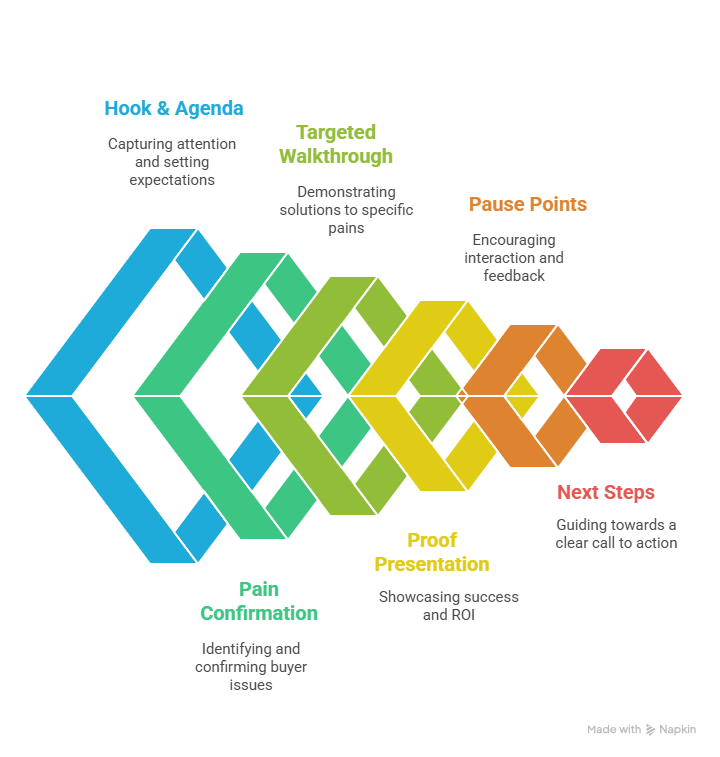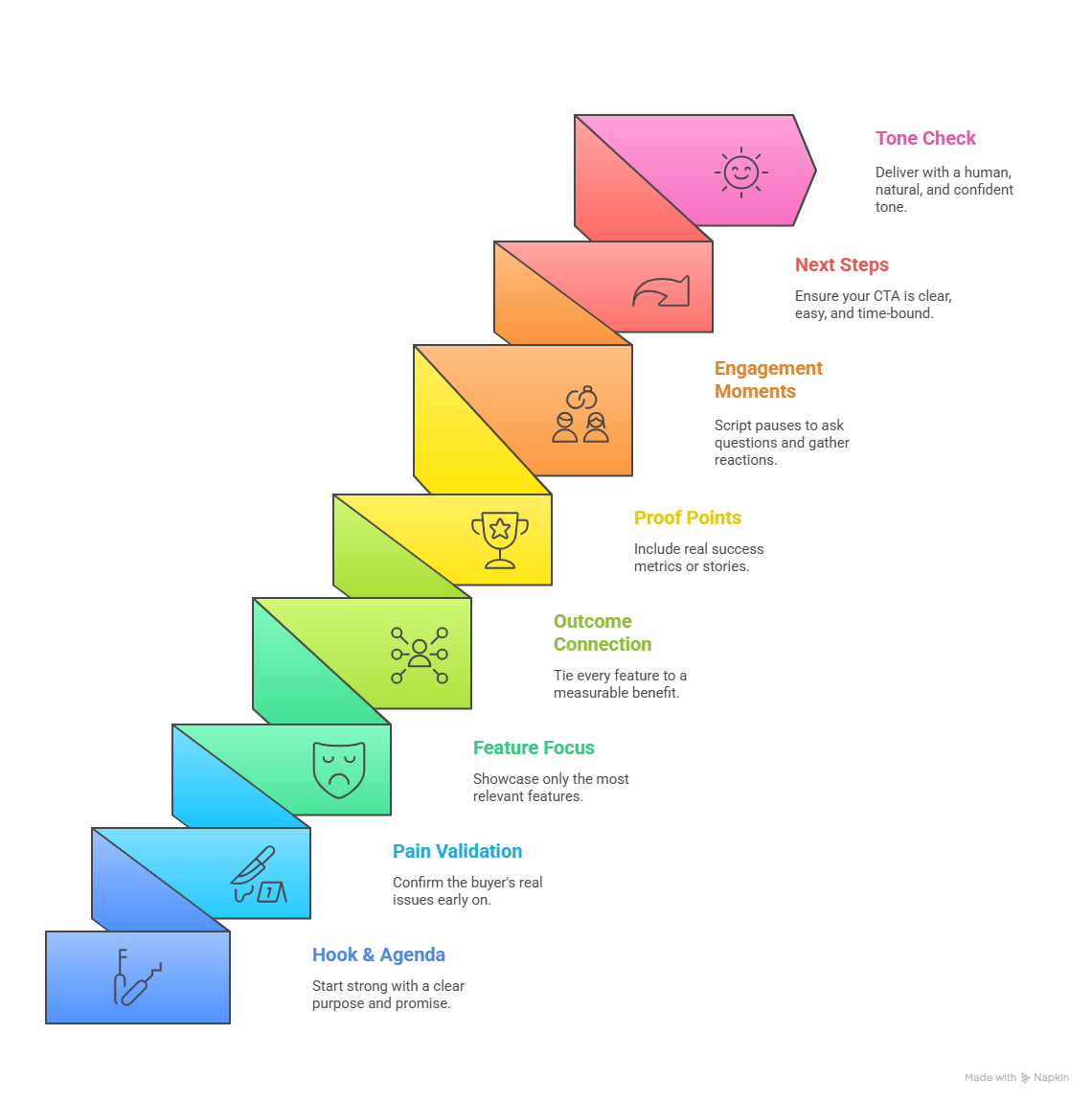What Is a Product Demo Script?

If you're in B2B sales or product marketing, you’ve probably sat through demos that felt like feature lists wearing a tuxedo, polished but painfully pointless. A Product Demo Script (PDS) fixes that. Think of it as the playbook that transforms a demo from a scattered tour of features into a focused, persuasive conversation that answers the buyer’s single biggest question: How will this solve my problem?
Here’s what you’ll take away from this post:
- What a PDS actually is
- Why it matters (hint: it speeds up deals)
- How to structure one effectively
- How to use different demo types at the right time in the funnel
- Practical templates to get started
- Common pitfalls to avoid
- A short checklist you can apply immediately
If you care about predictable demo outcomes, less wasted time, and demos that actually close deals, keep reading.
What Exactly Is A Product Demo Script?
A Product Demo Script is more than a rehearsed speech. It’s a structured roadmap that:
- defines the narrative flow of a demo,
- highlights the 3–5 features that matter most to the prospect, and
- embeds interactive checkpoints to validate interest and fit.
Rather than listing capabilities, a good PDS ties every demo moment to a buyer's pain point and the measurable outcome they care about. In short, it turns features into business results.
Why The Pds Is A Strategic Sales Asset
Let’s be honest, buyers don’t buy features; they buy solutions. A PDS reduces buyer risk by making the path to success explicit. That lowers friction (and buying hesitation), which accelerates deal velocity.
It also delivers operational wins:
- Consistency across reps and territories.
- Scalability for onboarding new sellers quickly.
- Personalization with guardrails, reps can adapt examples without losing core messaging.
And when the script maps to the buyer’s top pains (process, finance, support, product), it makes the demo immediately relevant.
Core Components Of A High-Converting Script
Every effective PDS should include:
- Hook & Agenda: a 30–60 second opening that frames the problem and what you’ll cover.
- Pain Confirmation: one or two quick questions or a poll that confirms the buyer’s primary issues.
- Targeted Walkthrough: demo the 3–5 features that solve those pains, each tied to a specific outcome.
- Proof: quick customer wins, ROI numbers, or before/after evidence.
- Pause Points: scripted moments for the prospect to react, ask questions, or confirm priorities.
- Next Steps: a clear, low-friction CTA (trial, deeper tech session, ROI model).

Short, focused, and outcome-driven, that’s the motto.
Script Frameworks You Can Copy
Pick a framework based on audience and stage:
- Foundational: Problem → Solution → How it Works → Outcomes → Next Steps. Great for mid-funnel demos.
- Evidence-Based: Before → After → Details → Proof → CTA. Ideal for execs and ROI-focused buyers.
- Four-Act Webinar: Problem (poll) → Solution (demo) → Proof (case studies) → CTA (offer). Best for larger audiences.
Use these as templates, then customize.
Match Script To Demo Type (And Funnel Stage)
- Recorded Demos (TOFU): Short, polished, value-focused. Use for discovery and traffic. See demo automation tools for Demo Creation to scale.
- Interactive Demos (MOFU): Guided click-through experiences that let users self-qualify. Script lives in the UX (tooltips, prompts).
- Product Tours (Post-sale): Granular, task-based guidance for onboarding.
- Live Demos (BOFU): Highly personalized, script is a flexible framework, not a monologue.
A smart company sequences these modalities so reps spend time only on truly qualified prospects.
Execution Tips: Common Pitfalls And How To Avoid Them
- Don’t be robotic. Practice so the script sounds conversational.
- Talk less, listen more. Top reps talk ~46% of the time. build pauses into the script.
- Avoid feature overload. Show the three to five features that actually solve the buyer’s problem.
- Measure and iterate. Track demo engagement, conversion rates, and talk-time ratios — then refine.
Record practice sessions, remove jargon, and use voice-over drills to tighten your delivery.
Quick PDS Checklist
Here’s a quick run-through before you hit that next demo:
- Hook & Agenda: Do you open strong with a clear purpose and promise?
- Pain Validation: Have you confirmed the buyer’s real issues early on?
- Feature Focus: Are you showcasing only the 3–5 most relevant features?
- Outcome Connection: Does every feature tie to a measurable benefit?
- Proof Points: Do you include at least two real success metrics or stories?
- Engagement Moments: Have you scripted pauses to ask questions or gather reactions?
- Next Steps: Is your CTA clear, easy, and time-bound?
- Tone Check: Does your delivery feel human, natural, and confident?
Double-check these before every demo: consistency builds credibility, and credibility wins deals.

Conclusion:
A Product Demo Script is the secret ingredient that turns demos from noise into a deliberate sales engine. It creates clarity for buyers and consistency for sellers, and when done right, it accelerates revenue.
If you want to automate demo creation and deliver personalized demo videos at scale, check out this Product video demo maker. Ready to build a script library and start A/B testing demo flows? I promise, a little structure goes a very long way.
FAQs
Q1: What’s the importance of a script in product demos?
A demo script gives your presentation direction and purpose. Instead of winging it, you have a guided roadmap that ensures every moment of the demo connects to your buyer’s needs. It helps you highlight what truly matters and eliminates unnecessary tangents that waste both your and the buyer’s time.
Q2: How does a demo script keep the demo focused and structured?
A well-crafted script acts like a map; it tells you where to start, what checkpoints to hit, and how to close. It keeps the flow smooth, transitions naturally, and prevents the “feature dump” problem. You’re not guessing; you’re leading the conversation toward a clear business outcome.
Q3: Why is consistency across demos so important?
Consistency builds trust. When your entire sales team follows a unified narrative, it reinforces your brand message and value proposition. It also makes performance measurable, because when everyone follows the same core framework, it’s easier to identify what’s working and what needs tweaking.
Further Reading
- How to Run a Great SaaS Sales Demo: Winning By Design offers a solid framework on how to structure demos that resonate with prospects.
- How to Write a Winning Sales Demo Script: Saleo’s guide on turning features into digestible, scenario-based narrativ
- The 5 Acts of Winning Sales Demo Scripts: Gong breaks down a creative, high-impact structure that top performers follow.

Sarah Thompson is a storyteller at heart and Business Developer at PuppyDog.io. She’s passionate about creating meaningful content that connects people with ideas, especially where technology and creativity meet.






